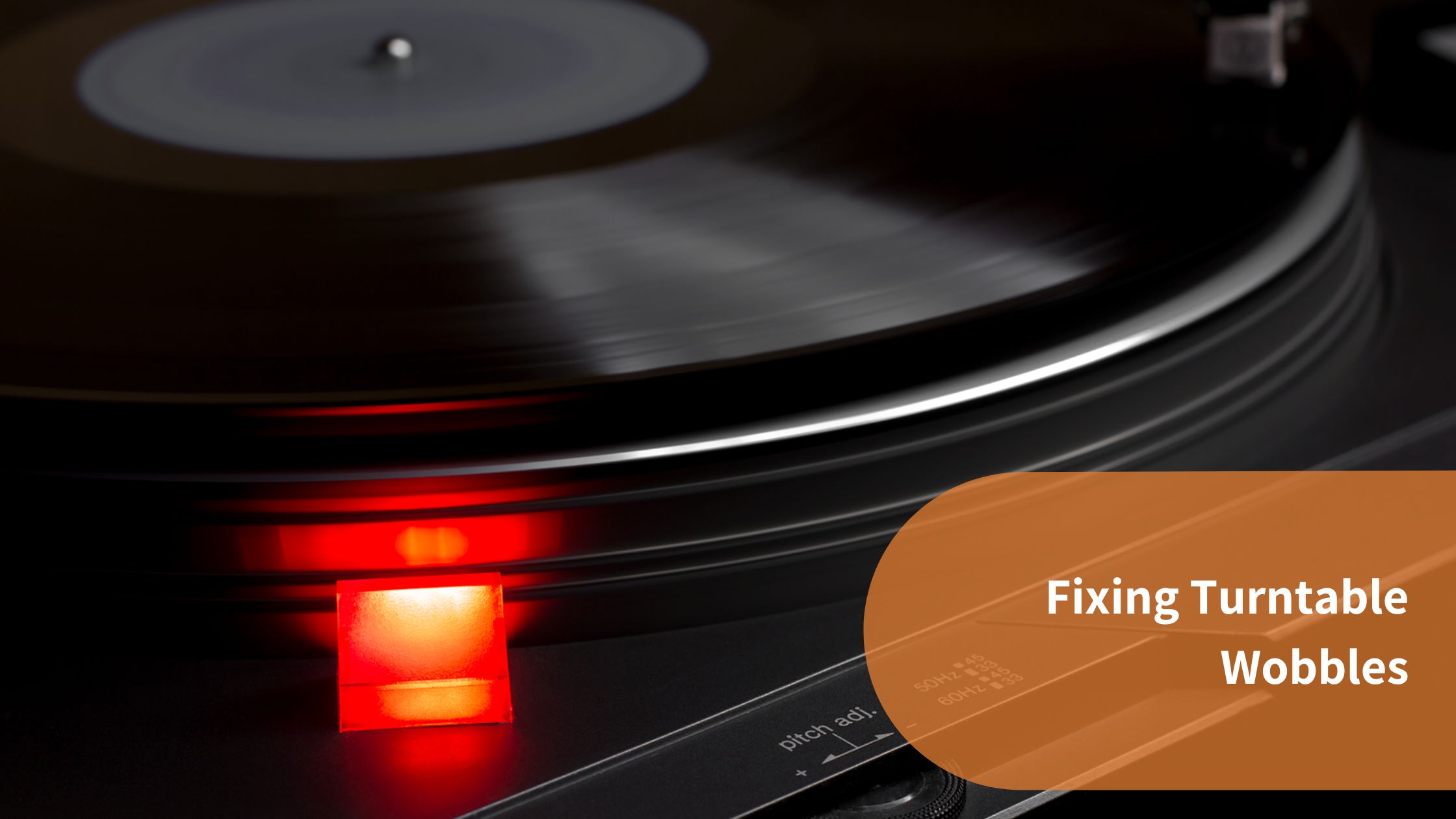No matter what kind of turntable you own, there’s a good chance it’ll need some adjustments or maintenance eventually. One of the most common issues listeners run into is a bit of turntable wobble, and this can be caused by many different reasons.
Some record players are more susceptible to this than others, but there could be external causes that lead to wobbling as well. In this article, you’ll learn about the 9 reasons why your turntable wobbles and how to prevent it moving forward.
1. Uneven Surface
Simple put, for a vinyl record to deliver the best audio playback, it requires your turntable is set on a flat surface. No matter how structurally sound your record player is, if there’s any tilt in its position, this could cause numerous issues with your equipment and vinyl records. Sometimes this can be hard to discern initially, as it doesn’t take much to affect how a turntable reads your records.
Most people avoid this issue by placing their record player on an even shelf or tabletop. A good way to make sure a surface is flat and even is by using a level measurement tool, which will immediately tell you if the surface is flat or not. Better yet, you can easily find many apps on smartphones that have this capability as well, and you don’t need much expertise to use this tool properly.
Keep in mind that even the slightest slant in a surface can make a significant difference, and you may not be able to detect this issue with the naked eye. Of course, there are many other reasons your records could be wobbling, but this is a good starting point before diving into the build quality of your record player.
2. Warped Records
This is an issue that many inexperienced vinyl enthusiasts encounter, as one mistake can lead to a warped record. From another aspect, it’s common to run into imperfect vinyl records when you go shopping, as a lot of them have been in circulation for quite a long time. Outside of that, there are quite a few things you can do to ensure your record collection stays in the best shape possible.
When they’re manufactured, vinyl records should be perfectly flat for the most part, but if you start to notice some visible wobble, then it’s time to look into what could be causing it. Records can become warped for a number of reasons, such as being exposed to excessive heat or leaning under the weight of the rest of your vinyl collection.
It’s important to safely store your collection in an upright position, as warped records can be a substantial issue for their audio quality. Thankfully, there’s more than one technique you can use to fix a slightly warped record.
3. The Turntable Platter
In the unfortunate event that the turntable itself causes the wobble, there’s a possibility that it could be coming from the record player’s platter. Although many quality machines come with a perfectly flat platter, this issue isn’t necessarily unheard of. Whether it’s due to poor manufacturing or maintenance, a turntable’s platter wobble that has too much platter wobble can be a problem.
It should be mentioned that a slight variation of wobble is okay, and you may not hear any difference in the audio playback at all. Suppose the platter wobble variance is noticeably significant. In that case, it can not only affect your listening experience, but it could potentially lead to damage to the surface and grooves of your records.
This can be fixed with a little maintenance, and you may need a new platter or sub-platter entirely or look into having it leveled. Nevertheless, this doesn’t have to be a permanent issue, and it’s important you don’t let it go for too long, so the quality of your records doesn’t suffer from it.
4. Check the Turntable Belt
You might run into complications with their belt drive in older turntables or those who haven’t received the upkeep they need. Over time, these belts can become weaker and less reliable, and many people who aren’t familiar with record players tend to overlook this potential issue.
If the belt happens to be too loose or not operating at a consistent speed, it could cause a platter wobble effect. You may be able to visually see this wobble, but you’ll also be able to hear discrepancies in the audio itself. In most cases, the belt is located under the platter, and it’s common for them to expand over time as they age.
No need to be too concerned as belts can easily be replaced, and this should act as an instant fix unless something else is adding to that unwanted wobble. There are many tutorials you follow online to replace it yourself, or you can find a shop to handle it for you.
5. Dust and Debris
From your records down to your turntable’s external and internal components, it’s essential that all of your equipment is as clean as possible. It might be difficult to believe, but dust and debris on your vinyl records and turntable equipment can lead to issues with your audio and produce a visual and audible wobble effect.
This isn’t too hard to handle, of course; it just means you need to be more consistent with your record-cleaning routine. Give your records a good wipe-down with a microfiber cloth, and then spend a little time cleaning the ins and outs of your record player for the best listening experience.
Even though many turntables are built with covers to help mitigate this, you should still have a consistent cleaning schedule for your equipment. Since some turntables have a few areas that can be hard to reach, using a can of compressed air can be helpful here, but be careful not to damage any surrounding sensitive parts with this method.
6. Rubber Mats
The platters on turntables generally come with a rubber mat underneath. Although that can be quite beneficial to help reduce excess noise and vibrations, it can also do the complete opposite if the rubber isn’t in good shape. This is something that can occur either from poor maintenance conditions or due to old age.
If the rubber isn’t level, it could easily affect the movement of the platter, which could lead to some wobbling. This is another part that isn’t too difficult to repair, but it may go unnoticed if you aren’t specifically looking for it as a potential issue.
Audiophiles may be well versed in maintenance, but many casual listeners won’t think to look at certain parts of the turntable when it comes to audio and performance complications. This is another reason it’s important to keep your equipment in a dry and cool place, as rubber can easily be affected by temperature, friction, dust, and debris.
7. Bent Spindle
This may be more of a rare occurrence, but if the spindle of a record player is bent, this will undoubtedly cause some wobbles. Although it would take some force to make this happen, a bent spindle could be found with used turntables or if it happened to take some damage during shipping.
It also may require professional maintenance if you aren’t too familiar with the parts of a record player. A spindle is what sits at the center of your platter and is an extended part of the motor shaft.
Once again, this isn’t the most common cause of wobble in turntables, but it can happen if the spindle is even slightly bent. Considering a slight shift in the spindle’s positioning can cause numerous complications, it may be hard to spot initially. A good way to tell if it’s bent is by viewing it at eye level to see if it’s angled at all.
8. Swaying Tonearm
Some of the issues listed in this article can create somewhat of a domino effect. If a record isn’t even or possibly warped, the tonearm won’t be able to track properly and it may sway while tracking the record. This undoubtedly will affect the audio playback and might be your first indicator that something is wrong.
At first, you might think something is wrong with the tonearm when it could be related to your vinyl records or even the turntable platter. From an overhead visual perspective, you’ll primarily notice the odd movement of the tonearm, but it may require further inspection to find the cause of the swaying.
Even if the tonearm isn’t the root of the problem, it’ll still add to issues with the audio quality, and it’s important to inspect the tonearm as well to ensure it’s operating as it should. Nevertheless, this particular issue is generally caused by something else, and inspecting your records and the turntable’s mechanics on a regular basis can be advantageous.
9. Turntable Feet
This goes hand-in-hand with the uneven surface section above, but you’ll also want to consider the feet of the turntable may not be level. Whether they were manufactured this way or took on some kind of damage, if the feet aren’t level, it could easily cause playback issues.
Moreover, it’s possible to notice a wobble in your records, and it can be fairly frustrating as most people don’t think to check the feet of their turntable. Many record players may come with rubber or felt padding on the bottom of their feet, and the slightest variation in height between the feet can significantly affect your listening experience.
Whether they need repair or a missing part, such as a piece of rubber or felt, this issue shouldn’t be too hard to fix. This is another reason that isn’t too common, but it can definitely happen, so it never hurts to check.
Are Turntables Supposed To Wobble?
Technically, a brand-new turntable isn’t supposed to wobble at all, but a little variance is actually quite common. With the many different causes that are listed in this article, you’re bound to encounter a little wobble at some point.
What’s important is that you thoroughly check your vinyl records and record player for any discrepancies so you can source what’s causing the wobble. Always keep in mind that it could be a number of complications, and it may require more than one repair to get the wobble to stop.
Some fixes are easier than others, but a majority of the complications in this article can be mitigated on your own. Of course, if you aren’t comfortable performing maintenance on your record player, it’s always advisable to take it to a professional.
How Much Wobble Is Too Much?
You can start by looking at the platter to get a reference for what’s considered too much wobble. It’s optimal to have a 0mm variance in the platter as that provides a seamless experience, but some people agree that a little variance is normal, while others think there shouldn’t be any at all.
I’d say the maximum variance most people can bare is about 5mm, as that’ll be pretty noticeable, even from a distance. There’s a possibility it could get worse, which could potentially damage your vinyl collection, so it isn’t something that should simply be ignored.
If you were to ask different vinyl enthusiasts, you’re likely to receive different answers on how much wobble is too much, as some of it comes down to personal preference. However, if it’s affecting your listening experience, you should use the information in this article to source the cause before it becomes increasingly worse.
Record players can be intricate pieces of equipment that come with a decent learning curve. The more educated you are about their parts, the better prepared you’ll be to handle issues such as wobble during playback.

Lead Editor / Owner
After beginning his career in the video and audio recording industry, Andrew started HiFi Hippo to share his knowledge and passion for vinyl and vintage audio with other readers.
